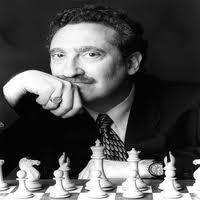
Pandolfini's Puzzler #16 - Copycat Chess
The Professor had a twinkle in his one good eye. The other eye wasn’t too good either, but he tried to keep that a secret.
---
“It’s so odd,” he began. I often see players with the black pieces play for a draw out of the opening. Do you know the way many of them would try to do it?” was the first question Professor put to his special class of young players.
---
Today’s group was a little bigger. In addition to Zephyr and Lucian, six other youngsters had joined them. Still, only Zephyr and Lucian had the courage to speak up.
---
With a gleam, Zephyr raised her hand right away, hoping to be called on, and the Professor indeed did so.
---
“How do you think they would try to do it, Zephyr?” the Professor asked.
---
“Well, I think that many of them would copy the white moves. That wouldn’t work, of course, but that is what I think they would try to do,” Zephyr stated with emphasis.
---
“You bet,” Lucian blurted out. “It’s silly for the black pieces to copy the white ones. There are no last licks in chess. If you get mated first, the game is over, and that’s that,” Lucian added.
---
“And that brings us to today’s problem,” the Professor interjected. “Consider the very starting position of a chess game.”
---
---
Question: From the start of a game, if both players copy each other for the first three moves, how can White checkmate on the fourth move?”
---
The entire class began to think about this one. After no more than a minute, it was Lucian who offered the first comment, this time waiting to be called on before speaking up.
---
“What about the Scholar’s Mate?” Lucian asked. “If Black copies White, doesn’t White mate on the fourth move, after 1. e4, 2. Qh5, 3. Bc4, with 4. Qxf7 mate?”
---
“I’m afraid that doesn’t work, Lucian,” the Professor replied. “Can anyone tell me why?”
---
Zephyr had the answer. “Since the black queen has moved to h4, the square d8 is clear, so 4. Qh5xf7+ is not mate.”
---
---
“Very good, Zephyr,” the Professor exclammed! “So where does that leave us?
---
Another minute went by, and Lucian felt the need to get something cleared up. So he asked: “Black is copying White, but can they play bad moves and get away with them? If they can, I think I have the answer.”
---
“They can play bad moves, as long as Black copies White for the first three moves,” the Professor explained. “But I must ask, if you have found a solution to the problem, which one of the three solutions did you find?”
---
The puzzled class looked even more puzzled. Not only did they have to find one solution, they had to find three solutions! But the class used its next 10 minutes wisely, working in two teams, one headed by Zephyr, and one by Lucian.
---
And guess what? They did find all three solutions. Can you?
---
Answers below - Try to solve Professor Pando's puzzle first!
---
ANSWER #16
---
The three “copycat” ways to play are:
---
(1) 1. d4 d5 2. Qd3 Qd6 3. Qf5 Qf4 4. Qxc8 mate.
---
---
(2) 1. d4 d5 2. Qd3 Qd6 3. Qh3 Qh6 4. Qxc8 mate.
---
---
(3) 1. c4 c5 2. Qa4 Qa5 3. Qc6 Qc3 4. Qxc8 mate.
---
---
The moves for the above solutions are not easy to find because each line relies on illogical, bad moves, such as putting the queen where it can be taken for free (what chess players would describe as en prise).
---
Take note
---
There are times in chess when one naturally seeks a draw out of the opening (for instance, in cases where a draw helps a player win a tournament or match). But the right way to play for a draw is not by copying your opponent. A better approach is to get a good game, with lots of play and counterplay. Put enough pressure on your opponent, instead of merely copying him or her, and he or she is more likely to accept your draw offer.
---
Still, most good players don’t necessarily play to draw. Rather, they play not to lose, still aiming to win, but not by trying unreasonably or riskily to do it.
RELATED STUDY MATERIAL
- ProfessorPando gave an example of when to play for a draw - read more about when to accept a draw here;
- StrongHeart has a great video explaining draws and when grandmasters accept them;
- Poppbear shows why copying your opponent is not really a good strategy.






